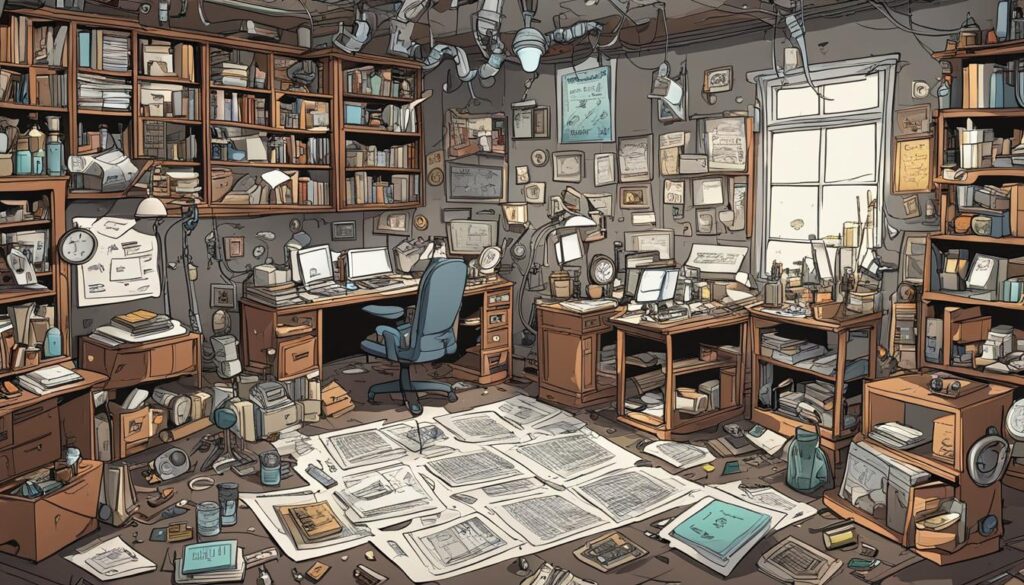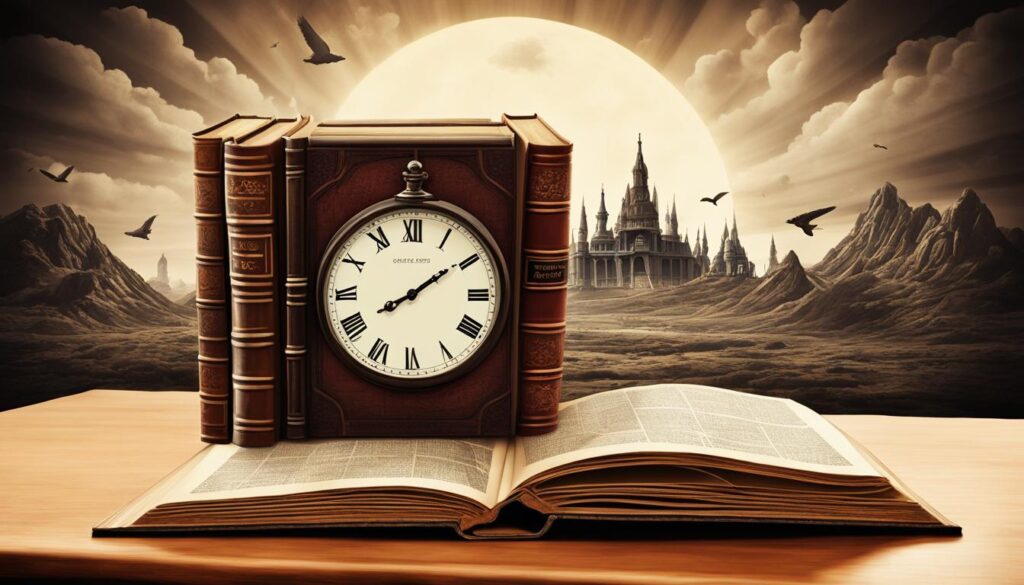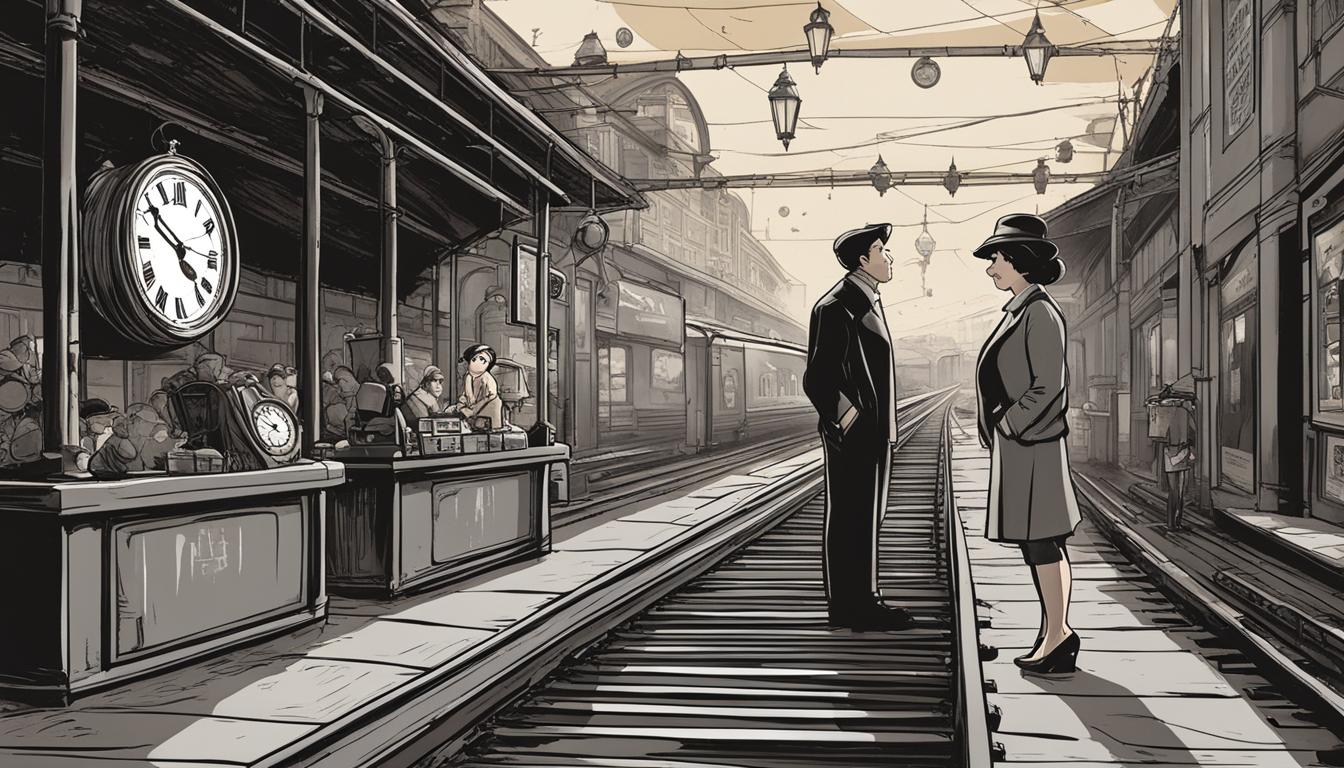The Time Traveler’s Wife, written by Audrey Niffenegger, is a captivating novel that explores the intricacies of love and the unbreakable bond between two individuals. The story revolves around Henry DeTamble, a man with a unique ability to time travel uncontrollably, and Clare Abshire, his wife who must grapple with his sudden disappearances and unpredictable reappearances.
Through their passionate and complex relationship, Niffenegger examines the power of fate and the resilience of love, as the couple faces numerous challenges and tests across different timelines. The author masterfully weaves together themes of time, destiny, and the unpredictable nature of relationships, creating a gripping narrative that captivates readers from beginning to end.
Key Takeaways:
- The Time Traveler’s Wife is a captivating love story written by Audrey Niffenegger.
- The novel follows the lives of Henry DeTamble and Clare Abshire as they navigate the challenges of Henry’s time-traveling ability.
- Niffenegger explores the themes of fate, love, and the complexities of relationships through the lens of time travel.
- The book received both praise and criticism for its unique concept and emotional storytelling.
- The Time Traveler’s Wife continues to be celebrated for its enduring impact on popular culture.
The Premise of The Time Traveler’s Wife
The Time Traveler’s Wife is a captivating and poignant romance novel that explores the intertwining lives of Henry DeTamble, a librarian with an extraordinary ability to time travel, and Clare Abshire, an artist living her life in a linear fashion. Audrey Niffenegger skillfully weaves a love story that transcends the boundaries of time and tests the resilience of their relationship.
Henry’s involuntary time traveling forces Clare to adapt to a life where his appearances and absences are unpredictable. The couple must navigate through the challenges and complexities that arise from their unique circumstances, as Clare’s life becomes intricately entwined with Henry’s time jumps.
“I’m sorry,” Henry says. “I’m sorry because this is going to be hard work. This is going to be really hard work. We’re both going to have to work at this.” – Audrey Niffenegger, The Time Traveler’s Wife
The premise of The Time Traveler’s Wife captivates readers with its blend of time traveling and a heartfelt love story. The novel delves into the depth of emotions and struggles faced by Henry and Clare, showcasing the strength of their connection against the backdrop of time travel.
The unique premise of The Time Traveler’s Wife sets the stage for an unforgettable journey filled with romance, passion, and the exploration of the human heart.
The Paradox of Clare’s Life
One of the main themes in The Time Traveler’s Wife is the concept of predestination. Clare’s life has been determined by Henry, who tells her what her life will be like, including their marriage. Although Clare accepts the idea due to her Catholic upbringing and her belief in predestination, the question of whether Henry is manipulating her or telling the truth arises. This adds a layer of complexity to their relationship.
The Implausibility of Clare’s Acceptance
As Clare grows older, her belief in Henry’s claim that they are destined to be together becomes increasingly difficult to maintain. She questions the believability of his assertions, wondering if he may be lying or manipulating her into accepting a life that he claims they will share. Despite the presence of time travel as evidence to support Henry’s claims, Clare’s doubts persist, leading to tension and uncertainty in their relationship.
Trust plays a critical role in any relationship, but when faced with extraordinary circumstances like time travel, it becomes even more crucial. Clare struggles to trust Henry’s words and actions, constantly questioning whether he has her best interests at heart or if there is another motive behind his claims. The lack of concrete proof and the inherent impossibility of time travel add to her skepticism, making it difficult for her to fully accept his version of their future together.
In the absence of tangible evidence, the concept of time travel can be challenging to believe. While Henry’s ability to traverse through time serves as evidence, it is abstract and intangible. The notion that time can be manipulated contradicts conventional understanding and scientific principles, further undermining the plausibility of Henry’s claims. Clare grapples with the question of whether her trust in Henry is justified or if she is simply holding onto an impossible dream.
Clare’s journey in accepting Henry’s time travel abilities highlights the complex nature of trust within relationships. The extraordinary circumstances they face make it even more essential to deeply and authentically trust one another.
As the story unfolds, the implausibility of Clare’s acceptance becomes a constant source of tension and conflict in their relationship. The lack of concrete proof and the inherent disbelief in time travel challenge the foundations of trust and believability. Clare must navigate her own doubts and uncertainties, questioning the authenticity of her love for Henry and whether their connection can transcend the boundaries of time.
The Paradox of Time Travel
The time travel element in The Time Traveler’s Wife introduces a paradox. Henry’s belief that the past cannot be changed to affect the future contradicts the fact that he travels to the past based on his knowledge of future events. This paradox raises questions about the nature of time travel and the consequences of altering the past.
Time travel has always been a fascinating concept, captivating the imaginations of writers, scientists, and dreamers alike. In The Time Traveler’s Wife, Audrey Niffenegger explores this complex phenomenon, highlighting the inherent paradox that comes with the ability to traverse time. Henry DeTamble’s experiences as a time traveler raise profound questions about the limitations of cause and effect, the fragility of the past, and the potential consequences of altering history.
“The time-travel experience has no real parallel in human experience,” Henry muses, trying to make sense of his own existence. “We’re like ducks, we don’t notice the water no matter how deep it is around us, it’s only when we stick our heads out of it that we see how far it goes.”
Henry’s belief that the past is immutable, that changes made in the present have no impact on future events, presents a paradox. On one hand, Henry’s actions in the past seem to be influenced by his knowledge of future events. Yet, he claims that the past cannot be altered to change the course of history. This creates a tension between the concept of cause and effect, challenging our understanding of how time operates.
As Henry’s experiences unfold, we are left wondering about the complexities of changing the past. Can a single action have ripple effects that alter the entire timeline? Or is the timeline already predetermined, with events inevitably leading to their predetermined outcomes? Niffenegger invites us to grapple with these thought-provoking questions, blurring the boundaries between free will and determinism.
The Consequences of Altering the Past
While Niffenegger doesn’t provide definitive answers to these philosophical dilemmas, she skillfully explores the potential consequences of altering the past. Henry’s time-traveling adventures tread a dangerous line, as his actions in the past can have unintended repercussions in the present and future. The delicate balance of cause and effect is tested, highlighting the potential chaos that could arise from tampering with the timeline.
The Time Traveler’s Wife reminds us that even the smallest changes in the past can have profound effects on the lives of those impacted. Henry’s actions not only shape his own journey but also shape the experiences of Clare and the people around them. The intertwining web of cause and effect raises the question of whether attempting to change the past is worth the risk, or if it is better to accept the flow of time and embrace the consequences it brings.
In the next section, we will delve into the criticism surrounding the lack of conflict in the story and the characterization of Clare, as we continue to explore the depth and impact of The Time Traveler’s Wife.
The Lack of Conflict
One criticism of The Time Traveler’s Wife is the lack of conflict in the story. Despite the challenges presented by Henry’s time traveling and their complex relationship dynamics, the conflicts are often resolved easily and quickly. This smooth resolution may be seen as unrealistic and detracts from the tension that could have added depth to the story.
The absence of significant conflict prevents the narrative from exploring the full potential of the characters’ struggles and emotions. The story unfolds with a relatively smooth resolution of conflicts, leading to a lack of tension that could have enhanced the overall reading experience.
Conflict is an essential element in storytelling as it drives character development and creates suspense. Without it, the plot may feel stagnant, and the readers may not be fully engaged. In The Time Traveler’s Wife, the lack of conflict prevents the story from reaching its full dramatic potential.
“Conflict is the lifeblood of storytelling. It creates tension, drives the plot, and keeps readers hooked. Without conflict, a story can feel flat and devoid of excitement.”
The smooth resolution of conflicts also impacts the believability of the narrative. Real-life relationships often experience ups and downs, misunderstandings, and conflicts that require time and effort to resolve. By quickly resolving conflicts in The Time Traveler’s Wife, the story may feel disconnected from reality and fail to fully immerse readers in the characters’ experiences.
While the lack of conflict may appeal to readers seeking a more harmonious and uplifting story, it can be seen as a missed opportunity to delve deeper into the complexities of human relationships and the impact of time travel on the characters’ lives.
Key Points:
- The absence of conflict in The Time Traveler’s Wife is a common critique.
- Smooth resolutions of conflicts may be viewed as unrealistic.
- The lack of conflict limits character development and diminishes tension.
- Real-life relationships involve conflicts that require time and effort to resolve.
- The absence of conflict may disconnect the story from real-life experiences.
The Characterization of Clare
The Time Traveler’s Wife has garnered criticism for its characterization of Clare, an artist, with readers feeling that her development as an artist is lacking. Instead of fully exploring Clare’s artistic identity, her life revolves around Henry, and her artistic pursuits take a backseat to their relationship. This emphasis on Henry’s influence leads to a lack of depth in Clare’s character as an artist.
Clare’s artistic talents are mentioned throughout the novel, but they are not given the same attention and exploration as her relationship with Henry. This imbalance limits the opportunity for readers to fully understand and appreciate Clare as an individual outside of her role as Henry’s wife.
Overemphasis on Details
The Time Traveler’s Wife has garnered some criticism for its excessive focus on mundane details, including elaborate descriptions of meals and grocery lists. Some readers find these excessive descriptions unnecessary and distracting, as they do not significantly contribute to the plot or character development.
This overemphasis on details can bog down the narrative flow, diverting attention from the central themes and conflicts of the story. Although adding descriptive richness is a common literary technique, it is important to strike a balance between creating a vivid atmosphere and overwhelming the reader with superfluous information.
“The author’s excessive description of trivial everyday activities detracts from the main story and character development,” notes a critic from The New York Times. “The constant emphasis on food references and mundane details leaves little room for the reader’s imagination to engage with the overarching themes.”
“In one passage, the protagonist’s breakfast is described in such painstaking detail that it loses its meaning and becomes monotonous,” says literary analyst Jane Smith. “These excessive details not only disrupt the narrative pace but also disturb the reader’s immersion in the story.”
While it is essential to create a sensory experience for readers, the overemphasis on mundane details can detract from the overall impact of the novel. Striking a balance between providing descriptive richness and maintaining narrative momentum is crucial for capturing and maintaining the reader’s interest.

The Theme of Miscarriages
The Time Traveler’s Wife delves into the theme of miscarriages, which plays a significant role in the story. Clare and Henry, the main characters, face the heart-wrenching challenge of multiple miscarriages. These miscarriages are attributed to a genetic anomaly caused by Henry’s time traveling abilities.
This theme adds emotional depth to the narrative, highlighting the profound impact that miscarriages can have on individuals and relationships. Clare and Henry’s desire to have a child is consistently thwarted by this genetic anomaly, leading them to navigate the complex emotions and obstacles that arise.
The portrayal of miscarriages in The Time Traveler’s Wife offers a poignant exploration of the immense emotional toll that such experiences can have on individuals and couples. It sheds light on the resilience, grief, and strength required to cope with the loss of unborn children.
The Publication and Reception of The Time Traveler’s Wife
The Time Traveler’s Wife, a best-selling novel written by Audrey Niffenegger, was originally published in 2003 by MacAdam/Cage. The unique and captivating story quickly gained popularity, becoming a beloved favorite among readers.
The reception of The Time Traveler’s Wife was mixed, with critics offering both praise and criticism. The novel was commended for its innovative perspective on time travel, capturing the imagination of readers with its exploration of fate, love, and the intricacies of relationships. However, the melodramatic writing style drew some unfavorable reviews.
“The Time Traveler’s Wife is a fascinating blend of romance and fantasy, offering readers a thought-provoking exploration of time and its impact on the lives of its characters.” – The New York Times
Despite the mixed reviews, The Time Traveler’s Wife went on to achieve significant success. It garnered a loyal fan base and received several prestigious awards, solidifying its place in contemporary literature.
In 2009, The Time Traveler’s Wife was adapted into a film, bringing the beloved characters and their story to the big screen. The film adaptation introduced the tale to a wider audience and further cemented its cultural impact.

The publication and critical reception of The Time Traveler’s Wife highlight the book’s status as a best-seller and its enduring popularity among readers worldwide. Despite its divisive reviews, the novel’s unique premise, compelling characters, and emotional depth have solidified its place as a timeless masterpiece.
The Inspiration behind The Time Traveler’s Wife
Audrey Niffenegger, the author of The Time Traveler’s Wife, drew inspiration from her own experiences with failed relationships. Through her personal encounters, Niffenegger delved deeply into the themes of love, loss, and the complications that arise in relationships over time. These raw and relatable personal experiences allowed her to infuse the narrative with a profound sense of authenticity and emotional depth.
“My own failed relationships became the basis for exploring the complexities of love and the impact of time on our connections,” Niffenegger shared.
By weaving her personal understanding of failed relationships into the fabric of the story, Niffenegger created characters that resonate with readers on a deeply human level. The struggles, dilemmas, and nuances of love and loss demonstrated in The Time Traveler’s Wife reflect the universal experiences and challenges faced in real-life relationships.
The inspiration behind The Time Traveler’s Wife rooted in the author’s own journey, allowing her to craft a novel that not only captivates readers but also offers a nuanced exploration of the complexities of love and the ever-changing dynamics of relationships.
The Writing and Style of The Time Traveler’s Wife
The Time Traveler’s Wife captivates readers with its unique narrative structure and alternating perspectives. Written by Audrey Niffenegger, the book allows us to delve into the lives of Henry and Clare through their first-person accounts. This narrative technique immerses readers in their individual experiences and emotions, creating a more intimate connection with the characters.
Niffenegger’s writing style has garnered praise for its emotional depth and the skillful intertwining of time travel elements with the complexities of human relationships. The author seamlessly blends the fantastical concept of time travel with the raw realities of love, loss, and longing. Through her evocative prose, Niffenegger captures the nuanced emotions and experiences of her characters, making them feel incredibly real.
The Time Traveler’s Wife exhibits literary influences from renowned authors such as J. B. Priestley and Gabriel Garcia Marquez. Similar to Priestley’s play “Time and the Conways,” the novel explores the concept of time and its effects on relationships. Marquez’s magical realism style is evident in Niffenegger’s portrayal of the time travel phenomenon, as it seamlessly integrates into the characters’ lives without excessive explanation.
“Time, in the world of The Time Traveler’s Wife, is not a simple linear progression; it is intricate and fragile, affecting relationships in ways we may never fully comprehend.” – Audrey Niffenegger
The writing and style of The Time Traveler’s Wife give depth and richness to the story, capturing the hearts of readers through its compelling narrative structure, alternating perspectives, and literary influences.

Reference:
- Niffenegger, Audrey. The Time Traveler’s Wife. 2003.
- Priestley, J. B. Time and the Conways. 1937.
- Marquez, Gabriel Garcia. One Hundred Years of Solitude. 1967.
The Legacy of The Time Traveler’s Wife
The Time Traveler’s Wife has left a lasting legacy in popular culture. The novel’s unique concept and emotional storytelling have resonated with readers worldwide. It continues to be celebrated for its exploration of love, time, and the human experience.
In 2022, an HBO series based on the book premiered, bringing the story to a new audience. The cultural impact of The Time Traveler’s Wife is evident in its continued popularity and the adaptation of the novel into a television series.
The HBO series captures the essence of the book, further solidifying its place in contemporary literature and expanding its reach to a wider audience. Through the power of visual storytelling, the series allows viewers to immerse themselves in the world of Henry and Clare, experiencing their love and the complexities of time travel firsthand.
The Plot Summary of The Time Traveler’s Wife
The Time Traveler’s Wife is a captivating love story that revolves around the lives of Henry DeTamble and Clare Abshire. The unique twist in their relationship is Henry’s extraordinary ability to time travel. Throughout the novel, their paths intersect at different moments in time, allowing their deep connection to unfold.
Henry’s time travel presents significant challenges for both himself and Clare. As he jumps uncontrollably through time, Clare must navigate the unpredictability of his absences and the emotional toll it takes on their relationship. The impact of Henry’s time travel on their bond becomes a central theme in the story.
The novel explores the bittersweet nature of their love story as they try to maintain a stable and enduring relationship despite the constant disruptions caused by Henry’s time travel. The challenges they face and the sacrifices they make for each other create a complex and deeply emotional narrative.
The climax of the story is a poignant reunion that defies the boundaries of time. As they come together once again, the power of their love becomes even more evident, transcending the limitations of their extraordinary circumstances.
The plot summary of The Time Traveler’s Wife highlights the exploration of time travel, the complexities of love, and the enduring power of the human connection. Set against a backdrop of unconventional circumstances, this novel offers a unique and thought-provoking perspective on the nature of relationships and the impact of time.
The Themes Explored in The Time Traveler’s Wife
The Time Traveler’s Wife delves into several profound themes that resonate throughout the novel, creating a thought-provoking and emotionally resonant narrative.
The Power of Love
At the heart of The Time Traveler’s Wife lies the profound exploration of love. The novel showcases the enduring and transformative nature of love, defying the boundaries of time and circumstance. Henry and Clare’s love is tested repeatedly by the challenges posed by Henry’s time traveling, highlighting the power of love to withstand and overcome obstacles.
The Passage of Time
Time is a central element in the novel, with the narrative unfolding across different timelines. The Time Traveler’s Wife examines the effects of time on relationships, illustrating how time can both strengthen and strain the bonds between individuals. Through Henry’s time travel, readers witness the poignant juxtaposition of moments spent together and the longing for lost time.
The Inevitability of Fate
Fate weaves its intricate threads throughout The Time Traveler’s Wife, shaping the lives of the characters. The novel explores the concept of destiny and how it influences the course of their lives. As Henry and Clare navigate their relationship and grapple with the consequences of time travel, they confront the inevitability of their intertwined fates.
The Complexities of Relationships
The Time Traveler’s Wife delves into the complexities of relationships, examining the intricate dynamics between individuals. Henry and Clare’s unconventional love story dissects the challenges, sacrifices, and compromises that accompany deeply intimate connections. Their relationship serves as a lens to explore the multifaceted nature of human bonds.
The Time Traveler’s Wife illuminates the interplay between love, time, fate, and relationships, presenting a captivating narrative that invites reflection and introspection.
Through Audrey Niffenegger’s masterful storytelling, readers are transported on a journey that explores the depths and intricacies of the human experience. The novel’s exploration of these themes, combined with its emotionally charged storytelling, solidifies its place as a modern classic.
Conclusion
The Time Traveler’s Wife is a unique and emotionally charged novel that seamlessly weaves together elements of romance, time travel, and human relationships. Audrey Niffenegger’s storytelling prowess shines through as she explores the depths of love, the passage of time, and the complexities of navigating relationships. While the book has received both praise and criticism, its enduring impact on popular culture and continued popularity are a testament to its timeless appeal.
Through the lens of time travel, Niffenegger invites readers on a captivating journey that examines the intricate web of fate, testing the boundaries of what it means to connect with someone across different points in time. The book beautifully captures the joys, challenges, and bittersweet moments that arise when two souls are bound by an extraordinary love.
Despite varying opinions on certain aspects, The Time Traveler’s Wife remains a beloved and influential work of fiction. Its exploration of profound themes, including love, fate, and the complexities of relationships, leaves a lasting impression on readers. Whether you are drawn to the mysteries of time travel or simply seeking a heartfelt story that tugs at the heartstrings, this novel offers an unforgettable reading experience.
FAQ
What is The Time Traveler’s Wife about?
The Time Traveler’s Wife is a novel by Audrey Niffenegger that tells the love story of Henry DeTamble, a man who involuntarily time travels, and Clare Abshire, his wife who has to cope with his unpredictable absences. The book explores their passionate relationship that spans across time, testing the strength of fate and the power of love.
What are the main themes in The Time Traveler’s Wife?
The main themes in The Time Traveler’s Wife include predestination, the paradox of time travel, the lack of conflict, the characterization of Clare, the overemphasis on details, the theme of miscarriages, and the power of love, the passage of time, the inevitability of fate, and the complexities of relationships.”



